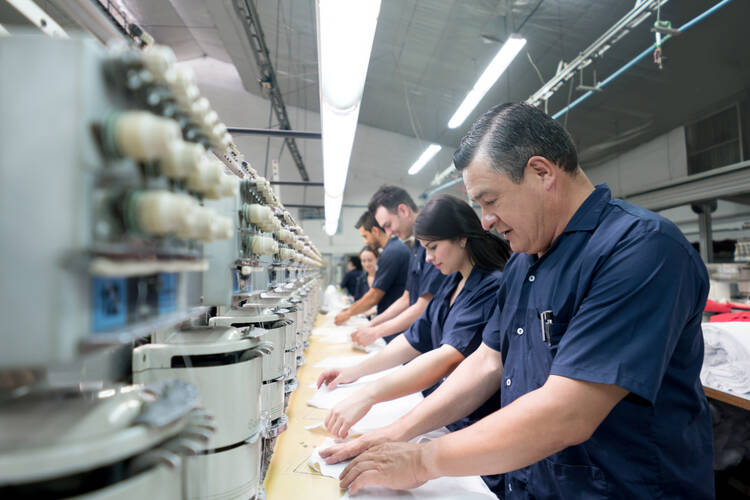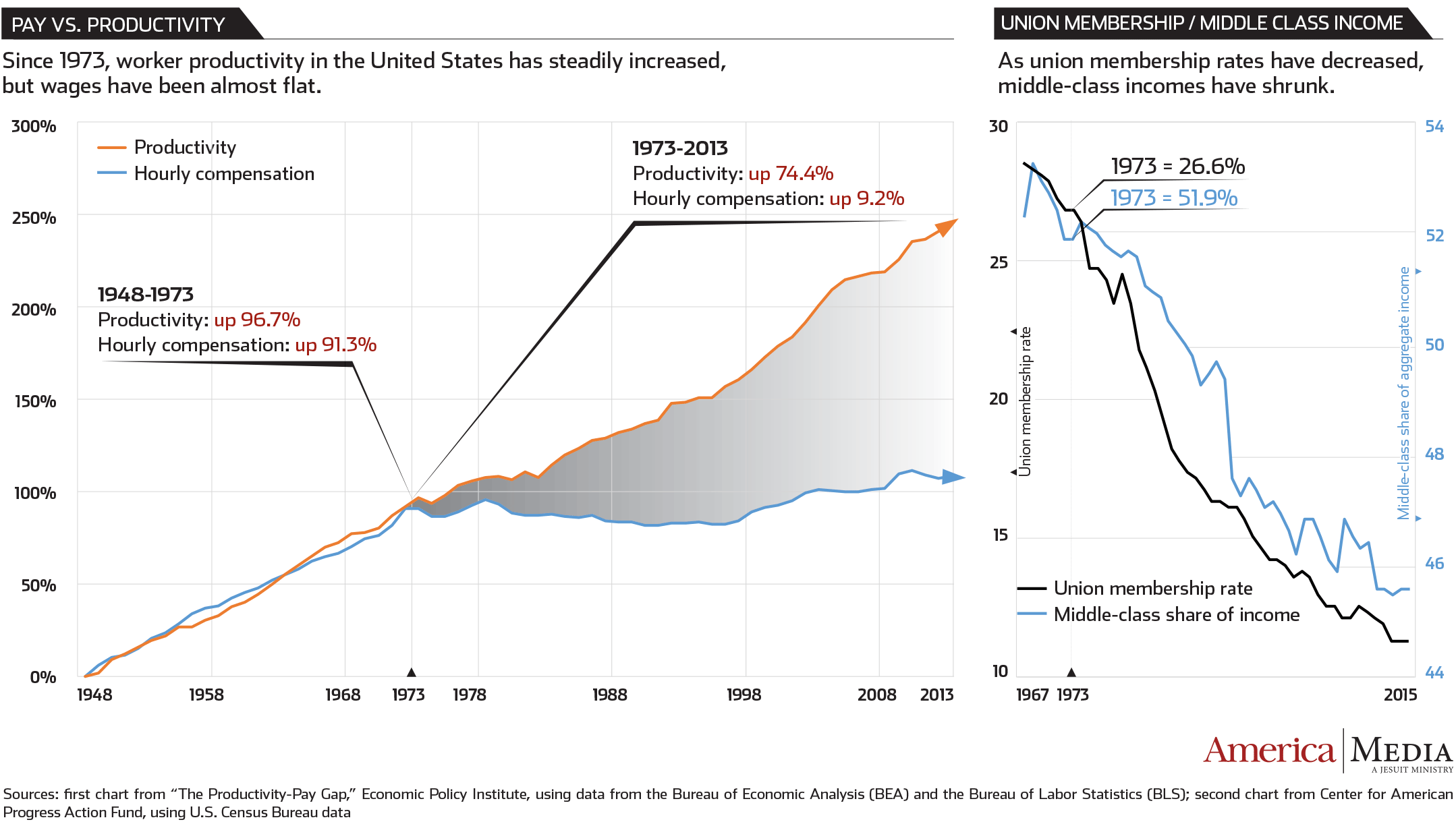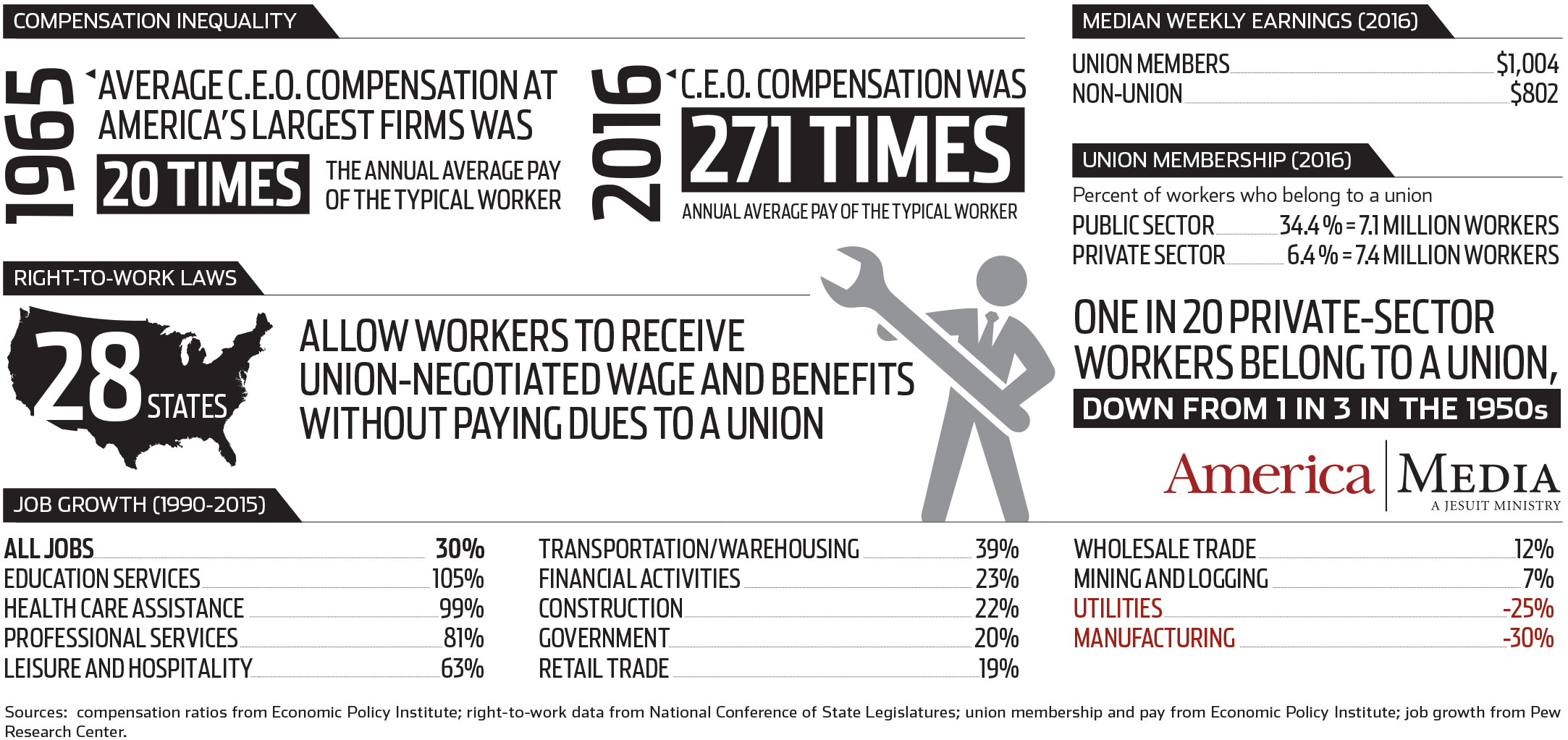August 23, 2017
Workers at an embroidery factory (iStock/andresr)
The current imbalance between supply and demand in the labor force should be good news for American workers still waiting to see a few extra bucks in their pockets after decades of income stagnation. Unfortunately, the nation’s 4.3 percent unemployment rate is not translating into fatter paychecks. Wages for most U.S. workers are still stagnant. In a tightening labor market, people are essentially working for less money than they did in the 1970s, at least when inflation is taken into account. What is going wrong?
According to some economists, part of the downward pressure on wages comes from the vast reserve of workers who, despite that low official rate of unemployment, remain on the sidelines of the formal economy. These discouraged workers are no longer tracked by the Bureau of Labor Statistics because of their long absence from the labor force, but many are still competing for full-time jobs. At the same time, mismatches between skills and job openings, as well as less direct effects on employment capacity (like the nation’s opioid epidemic), are keeping many U.S. workers from jobs with good wages.
Labor’s decline just about matches up to the swan dive of middle-class income in the United States since the 1970s.
But there are deeper issues that contribute to the withering of worker income and to destructive inequities in wealth distribution. The long-term decline of organized labor surely has had an impact. (See infographics on page 14.) In the not-too-distant past, organized labor could produce sizable ripple effects beyond its membership. Even nonunion workers benefited when organized labor pushed wages higher or scored improved job benefits or working conditions. Labor’s decline, in fact, just about matches up to the swan dive of middle-class income in the United States since the 1970s.
The current imbalance between supply and demand in the labor force should be good news for American workers still waiting to see a few extra bucks in their pockets after decades of income stagnation. Unfortunately, the nation’s 4.3 percent unemployment rate is not translating into fatter paychecks. Wages for most U.S. workers are still stagnant. In a tightening labor market, people are essentially working for less money than they did in the 1970s, at least when inflation is taken into account. What is going wrong?
According to some economists, part of the downward pressure on wages comes from the vast reserve of workers who, despite that low official rate of unemployment, remain on the sidelines of the formal economy. These discouraged workers are no longer tracked by the Bureau of Labor Statistics because of their long absence from the labor force, but many are still competing for full-time jobs. At the same time, mismatches between skills and job openings, as well as less direct effects on employment capacity (like the nation’s opioid epidemic), are keeping many U.S. workers from jobs with good wages.
Labor’s decline just about matches up to the swan dive of middle-class income in the United States since the 1970s.
But there are deeper issues that contribute to the withering of worker income and to destructive inequities in wealth distribution. The long-term decline of organized labor surely has had an impact. (See infographics on page 14.) In the not-too-distant past, organized labor could produce sizable ripple effects beyond its membership. Even nonunion workers benefited when organized labor pushed wages higher or scored improved job benefits or working conditions. Labor’s decline, in fact, just about matches up to the swan dive of middle-class income in the United States since the 1970s.
Worker productivity has steadily increased, but wages (and, not coincidentally, union membership) have been stagnant.
In the public sector, with 34.4 percent of workers represented by a union, organized labor is an embattled, if stubborn presence. But in the private sector, unions have essentially been eradicated. Nationally, organized labor represents just 6.4 percent of the workforce.
Without organized labor on the watch, upper management has claimed an increasing share of national income. In 1965, corporate C.E.O.s could anticipate earning 20 times more than one of their line workers; now, after peaking at 376 to 1 in 2000, that ratio is an astonishing 271 to 1. From 1978 to 2014, top management compensation increased by just under 1,000 percent—double the stock market’s growth and about 10 times the compensation growth experienced by workers over the same period. Class warfare indeed.
In the public sector, with 34.4 percent of workers represented by a union, organized labor is an embattled, if stubborn presence. But in the private sector, unions have essentially been eradicated. Nationally, organized labor represents just 6.4 percent of the workforce.
Without organized labor on the watch, upper management has claimed an increasing share of national income. In 1965, corporate C.E.O.s could anticipate earning 20 times more than one of their line workers; now, after peaking at 376 to 1 in 2000, that ratio is an astonishing 271 to 1. From 1978 to 2014, top management compensation increased by just under 1,000 percent—double the stock market’s growth and about 10 times the compensation growth experienced by workers over the same period. Class warfare indeed.
Union membership is now common only among public-sector workers.
Catholic social teaching has wrestled with such inequities in a number of ways, among them by calling for a just wage and a preferential option for the poor as mechanisms for mitigating imbalances, and even challenging the notion of private wealth itself with the concept of the universal destination of goods—under which, as St. John Paul II said, property “must always serve the needs of peoples.” But rarely has economic inequity been challenged as directly as it has been by Pope Francis. In “The Joy of the Gospel” he wrote: “Inequality is the root of social ills” (No. 202). In a 2013 speech at the Vatican, the pope targeted disparity as a “new, invisible...tyranny...which unilaterally and irremediably imposes its own laws and rules.”
He is right to be concerned.
Concentration of wealth is quickly followed by outsized political clout, closing a circuit that only exacerbates economic inequities. Because of this confluence of wealth and power, tax, spending and labor policies that favor the already wealthy become codified in Washington and state capitals around the nation. Among them has been so-called right-to-work legislation.
RELATED STORIES

Can Catholic social teaching help solve the labor crisis?
Rachel Lu

A new path for unions in America
Tom Deignan
In right-to-work states, workers may still form unions, but employees are not required to pay the dues that support them. That means “free riders” can enjoy whatever wage or benefit improvements unions are able to negotiate without joining their locals. In practice, right-to-work legislation has been a union killer. And once the unions and the power of collective bargaining they represent are out, no civic entity represents workers when the rewards of a robust economy are divvied up.
That legislative model is now being applied at the federal level. The National Right-to-Work Act, introduced most recently in Congress in February, has been gaining co-sponsors.
The president’s signature on a national right-to-work law could be the coup de grace for organized labor in the United States, a loss that will accelerate the wealth inequity that is already proving economically and socially ruinous.
This article also appeared in print, under the headline "The decline of unions is part of a bad 50 years for American workers," in the September 4, 2017 issue.
Source
Catholic social teaching has wrestled with such inequities in a number of ways, among them by calling for a just wage and a preferential option for the poor as mechanisms for mitigating imbalances, and even challenging the notion of private wealth itself with the concept of the universal destination of goods—under which, as St. John Paul II said, property “must always serve the needs of peoples.” But rarely has economic inequity been challenged as directly as it has been by Pope Francis. In “The Joy of the Gospel” he wrote: “Inequality is the root of social ills” (No. 202). In a 2013 speech at the Vatican, the pope targeted disparity as a “new, invisible...tyranny...which unilaterally and irremediably imposes its own laws and rules.”
He is right to be concerned.
Concentration of wealth is quickly followed by outsized political clout, closing a circuit that only exacerbates economic inequities. Because of this confluence of wealth and power, tax, spending and labor policies that favor the already wealthy become codified in Washington and state capitals around the nation. Among them has been so-called right-to-work legislation.
RELATED STORIES

Can Catholic social teaching help solve the labor crisis?
Rachel Lu

A new path for unions in America
Tom Deignan
In right-to-work states, workers may still form unions, but employees are not required to pay the dues that support them. That means “free riders” can enjoy whatever wage or benefit improvements unions are able to negotiate without joining their locals. In practice, right-to-work legislation has been a union killer. And once the unions and the power of collective bargaining they represent are out, no civic entity represents workers when the rewards of a robust economy are divvied up.
That legislative model is now being applied at the federal level. The National Right-to-Work Act, introduced most recently in Congress in February, has been gaining co-sponsors.
The president’s signature on a national right-to-work law could be the coup de grace for organized labor in the United States, a loss that will accelerate the wealth inequity that is already proving economically and socially ruinous.
This article also appeared in print, under the headline "The decline of unions is part of a bad 50 years for American workers," in the September 4, 2017 issue.
Source



No comments:
Post a Comment